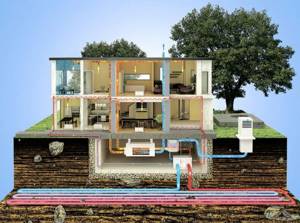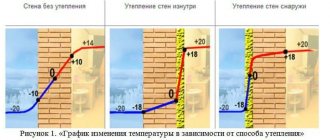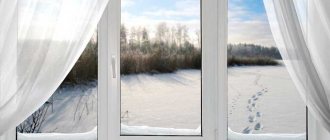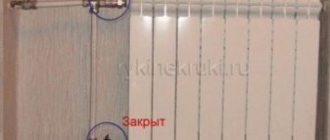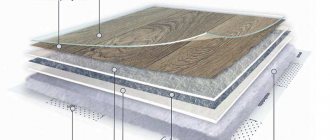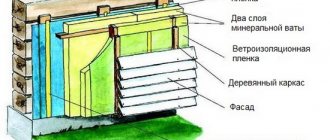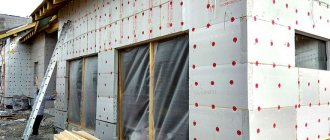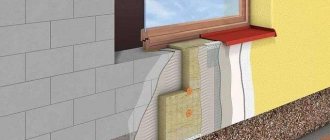Under the USSR, home owners got used to the fact that electricity and fuel cost a penny, and the insulation of houses and dachas received almost no attention. Now times have changed, and often the heating season can make a hole in the home owner’s budget. because of this, more and more attention is beginning to be paid to projects of the warmest houses, which are not so easy to build, but it is worth it.
They retain heat perfectly without taking into account the fuel spent on heating and materials that are extremely expensive and at the same time far from the most durable.
Find out where the heat comes from
Before heating the apartment, you need to make sure that this heat remains in it for a long time. If you take things seriously, you can arm yourself with a thermal imager. This is a device that uses sensors to determine the temperature of objects - it usually displays a multi-colored picture on the monitor: red colors indicate heat, blue colors indicate a lower temperature.
Prices for household thermal imagers on Yandex.Market start from 2827 ₽. It is more profitable to rent a thermal imager - for example, on Avito it will cost less than 1 thousand rubles.
A thermal imager will help you find places where the apartment is cooled. According to YouDo performer Stanislav Averkin, heat loss mainly comes from windows and balcony doors. But it happens that heat flows away from:
- the front door (especially if it leads directly to the entrance and not to the vestibule). In this case, it is recommended to change the seals on the door or insulate it additionally, or, if possible, change the door to a more reliable one or install double doors: for example, one iron door and the other a regular one;
- ceiling (if the apartment is on the top floor). You can insulate the ceiling from the inside - for example, by laying insulation between a regular and suspended ceiling. Or insulate the floor in the attic - for this you need to contact the management company that services your home;
- walls (if the apartment is corner, that is, behind the wall is not the neighbor’s home, but the street). You can insulate the walls using a special material, but it will “bite off” a few centimeters from the area of the room - and can also change the heat exchange in the apartment and lead to increased humidity and mold. It’s easier to rearrange the room and put a closet against the outer wall and move the bed further away. Well, a nostalgic option is to hang a carpet on the wall.
How to build a really warm house
A specialized insulating material that had a long service life, as well as load-bearing walls of the building, had not yet been invented. For this reason, very often simple building materials are used as insulation materials, for example, hollow or facing bricks, that is, they make the walls wider. This is very expensive, and also “eats up” useful space, which is not suitable for those who want to build a cheap and small house. If there is no choice, developers of inexpensive suburban housing continue to insulate buildings using popular methods, and during operation they are forced to constantly pay for repairs to the facade. It would seem that there is no way out of the situation, but still there is one.
Selection of wall materials
It’s not difficult to build a warm house with your own hands, and why not build a house from a material that itself is a thermal insulator. In general, any bricks perfectly insulate buildings, but budget developers prefer not to use it because of the high cost, and others do not use it because they believe that they are not thermal insulators at all. Reinforced concrete became one of the undervalued materials in construction outside the city - extremely durable and strong, from which bunkers and pillboxes were built in wartime. But now reinforced concrete is used in the private construction of houses, mainly only when creating foundations and ceilings. But what can you build walls from, and even comfortable, extremely beautiful houses? But why are reinforced concrete walls so bad? Developers blame them for being heavy and “cold”. We propose to consider whether this is actually so. Advantages of reinforced concrete walls compared to brick:
Walls cast from reinforced concrete are much “warmer” than brick ones, because there are no masonry joints in a monolithic wall, through which, as a rule, heat escapes.- Properly poured and mixed concrete is denser than bricks, which means it better resists moisture, physical impact and frost.
- Unlike brickwork, reinforced concrete walls are very flexible so as not to crack when the base subsides (and if the concrete walls are built on the same concrete monolithic slab, then there will be no subsidence at all).
- Concrete walls are built much faster than brick walls, and their price is much lower.
If we consider their properties from the point of view of heat conservation, then we should understand why concrete walls do not require any external insulation. The thing is that the concrete density will not allow it to warm up enough for the heat from the inside to reach the outside of the walls. So, a wall with a thickness of ½ meter will heat up by a maximum of 0.3 meters, and the rest of the walls will be cold, and only the extreme 5 cm will freeze in the most severe frosts. This does not mean that the outside of the wall should not be protected from freezing, but the protective technology is fundamentally different from wall insulation made from cellular and aerated concrete blocks. When building concrete walls, it is enough to cover the facade with special plaster with thermal insulation, and it will definitely not freeze, at least until the plaster begins to fall off. Even if so, it will cost several times less than all insulation materials, and it is also easy to repair, unlike expanded polystyrene or mineral wool, which simply cannot be repaired. So you will see that if instead of aerated concrete there is a porous type or cellular concrete, then you can get tangible savings both during construction and during the operation of the building. In addition to its quality for thermal conservation, reinforced concrete has certain advantages:
- A concrete wall is strong not just because of the properties of concrete in its pure form, but also because of the reinforcement, while block walls can collapse with a strong shock, for example, an earthquake.
- Reinforced concrete walls are not afraid of moisture, unlike aerated concrete and foam concrete - they will freeze almost right through, and therefore they should be well insulated, which will entail all the problems that were described at the very beginning of the article.
Now let's talk about the foundation.
Choosing the warmest foundation possible
Now you know what material to build a warm house from. If you decide to build an ideal and warm home, then it is important to pay attention to the other most important elements of the building - the base and roof. Here you can also do without insulation material altogether if both the base and the roof are made of reinforced concrete.
A foundation on a monolith slab is considered to be the warmest possible, but is not so popular among developers because it is very expensive and everyone chooses other cheaper options - strip and pile. But this is only the only drawback of such a foundation.
A slab foundation is a high-strength base for all buildings, which protects it from both moisture and cold, because a monolithic slab does not allow the soil to freeze underneath, which means it will not freeze itself. As a rule, such slabs are laid on a sand cushion, which is based on a dense layer of clay. This makes it possible to remove underground moisture from the base into the drainage system, and therefore under this base it will always be relatively dry.
Which roof is the best?
For some reason, few people thought about how suitable classic pitched roofs are for our Russian winters. They are very expensive, and they also get very windy and freeze. In this plan, a house with a reinforced concrete slab instead of a roof will, oddly enough, be cheaper and warmer. The main thing is to seal the joints between the slabs as best as possible, insulate the surface (simple sawdust is suitable), make a screed and cover the whole pie with waterproofing material. A durable concrete roof, which rests on concrete monolithic walls and the same base, can withstand all loads, even from snow. There are such advantages of a flat roof over pitched structures:
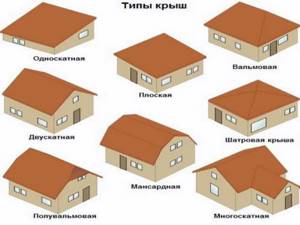
Unlike the latter, snowdrifts on a flat roof do not need to be removed, and what’s more, this is not recommended. It is the snow cap that will become an additional thermal insulation layer, which in the spring will melt on its own and flow from the roof through the gutters.- A flat roof will be cheaper for the developer during the construction process, since its area is smaller than that of a pitched roof, and it does not require building a rafter system or spending money on covering the roof.
- For a flat roof, you do not need to insulate or hire expensive specialists - you can do all this yourself and save money.
- You don’t have to spend money on regularly replacing damaged roofing materials and parts of the wooden rafter system, which simply cannot be protected from moisture and will constantly be consumed by rot.
- Through such roofs, heat does not escape from the house, and this saves heating.
- In case of rain or hail, such a roof will not rattle overhead all night.
On flat roofs you can create an ideal recreation area in the summer, which will fully replace a narrow and cramped balcony that will have to be constantly repaired.
- Such a roof will not be blown away by the wind, because it is not an obstacle to the wind.
So you see that if you approach the choice of plan-project and building materials for your country cottage wisely, you can not only build yourself the most durable and warm house that will not need repair work in the next decades, but also save a lot on heating, as well as other factors. In suburban construction, the option of building like everyone else is far from the best solution. It would be more correct to study the qualities of building materials and independently figure out which of them will help you save money, while eliminating constant problems with repairs.
Deal with batteries
If the heating season has already begun, and the radiators remain cold (or barely work), then contact the management company (MC) that services your home. In Moscow, for example, the telephone number of the management control room can be found on the “House of Moscow” website. Tell the dispatcher your address and problem - they will send a specialist to your home to help solve it.
According to official standards, the air temperature in the apartment should not be lower than 18 degrees Celsius. If the house is colder, then call a representative of the management company - he will issue a statement with which you can recalculate payments for heating or maintenance of the house.

Source: rg.ru.
Design differences
Walls
For a summer house built for temporary residence, you can build a simple infill structure and sheathe the house with plywood or OSB on the sides. Then it is enough to place any insulation in the middle; you can even use dried and processed sawdust.
However, experts advise building cottages from profiled or laminated timber of small cross-section. Such buildings can easily withstand several years of winter. It will not be hot in them in the summer, and warming up such a room is much faster and easier.
With permanent houses the situation is much more complicated - in this case, the main thing is reliability.
Let's look at the main building materials used to build walls in country cottages:
- wood: this is a log: chopped, rounded, timber: profiled, glued, insulated - the choice is huge;
- brick - has proven itself in private housing construction, in terms of durability, sound and heat insulation;
- foam concrete or aerated concrete are materials with good quality characteristics, but you should know that they are afraid of moisture and need additional insulation;
- SIP panels are a new building material on the market, but have already become popular among many developers.
It is worth noting that any of these materials, in the hands of competent and highly qualified builders who will follow construction technology, can turn into a high-quality and durable home for comfortable living on a permanent basis.
Insulate windows
Here are the main reasons for drafts from closed windows:
1. Poor fit of the valves.
This may be, for example, due to wear of the rubber seals or improper operation of the fittings: handles, hinges.
You can tighten the window sash fittings yourself - using a hex key, which you need to turn the trunnions (this is a hexagon on the side of the window sash) so that the seal fits tighter to the frame, explains Stanislav Averkin. You can learn this from a YouTube video or consult a video conference with a specialist, for example, from YouDo or Profi.ru.
If the problem is that the fittings are worn out, then they can be replaced with the help of specialists. There is no need to change the windows themselves for this.
2. Poor quality of installation.
If it blows not from the sashes, but from under the window sill or in the corners, it’s a matter of installation quality, says Stanislav Averkin. In this case, the expert advises to reinstall the windows. For the installation of one window - for example, in the kitchen - you will have to pay about 5 thousand rubles.
If reinstalling the windows is impossible, then all that remains is to insulate them with improvised means. For example, you can use a special sealant (from 100 ₽ per bottle), foam rubber, self-adhesive sealant (from 100 ₽ per piece) or the old method - cotton wool and masking tape. But, according to expert Stanislav Averkin, you shouldn’t do this: it would still be safer to replace the windows with new ones.
Description of the insulation process with your own hands
*
The insulation process varies depending on the type of insulation and material.
How to insulate your apartment from the outside if the heating is bad
The most popular type of external insulation is polystyrene foam. The sequence of actions is as follows:
- Calculate the insulation area and material thickness. Buy it.
- Based on the amount of insulation, purchase glue, fiberglass mesh, mounting metal profile, disc dowels.
- Secure the metal profile while maintaining the level.
- Glue the insulation boards to the wall.
- Secure with disc dowels at the rate of 4-5 per panel.
- In cold regions, polystyrene foam is glued in two overlapping layers.
- Seal joints and cracks with polyurethane foam.
- Apply a thin layer of glue to the foam, press and roll the mounting mesh with a rubber roller.
- After the glue has dried, prime and plaster the surface.
- Instead of plaster, you can use facade paint.

Such work can be carried out independently only on the first floor. Above that, you will have to involve a specialized construction organization.
How to insulate a cold room from inside the apartment with your own hands
For interior work, experts recommend using mineral wool.
The sequence of actions will be as follows:
- Calculate the amount of insulation.
- Purchase it and the corresponding quantities of a vapor barrier membrane, guides made of metal profiles, fasteners, primer, plaster or moisture-resistant gypsum board.
- Remove any remnants of old wallpaper or paint from the wall down to the concrete.

Internal insulation scheme
- Impregnate the wall and adjacent surfaces with an anti-mold compound
- Secure the upper and lower starting and finishing profiles. Attach vertical guides to them in increments of 60 cm.
- Place mineral wool slabs between the wall and the profile.
- Secure the slabs with disc dowels.
- Stretch the film of the vapor barrier membrane, securing it with double-sided tape. The joints between the membrane sheets also need to be taped.
- Attach sheets of moisture-resistant gypsum board to the vertical guides.
- Putty it, prime it, then paint or wallpaper.
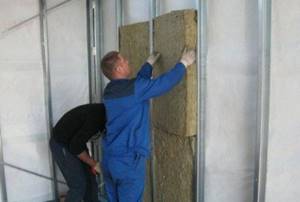
All joints of the side walls, ceiling and floor with the external wall must be covered with silicone sealant or foam glass.
How to care for windows so they last a long time
When dirty, you need to wipe the glass and window sill with a soft cloth soaked in soapy water, or use products designed for cleaning windows. Do not use scratching sponges or powders, acids, or alkalis.
Internal parts, mechanisms, hinges, seals - if they are of high quality - are lubricated in production with special materials. If the apartment is undergoing renovation, it is better to cover the windows with film to protect them from construction dust, advises Stanislav Averkin. About twice a year you can apply silicone grease to the fittings (approximately 100 ₽ per bottle).
Good windows - if high-quality installation was done - can last about 10 years, after which, most likely, the fittings will need to be replaced.
Property information
Object: residential building with a total area of 246 m²
Design and construction:
Materials and equipment: permanent formwork, reinforcement, concrete, Neopor polystyrene foam, waterproofing, energy-efficient windows and doors, Zehnder recuperator (Germany), Nibe heat pump (Sweden)
House box cost: RUB 25,000/m²
The wall “pie” of the house is a multi-layer structure (from the inside out): a layer of expanded polystyrene 50 mm thick, supporting a frame made of monolithic reinforced concrete, a layer of expanded polystyrene (100 mm) and 150 mm of energy-efficient polystyrene foam “Neopor”, covered with facade plaster
The house has windows with wooden frames and thermal insulation liners made of polyurethane foam. Double-chamber double-glazed windows are filled with argon, and a selective heat-reflecting transparent coating is applied to the surface of the outer and inner glass. The window frames are separated from the concrete enclosing structures by a layer of expanded polystyrene (permanent formwork), and on the outside they are adjacent to a layer of “Neopor”, which almost completely eliminates the possibility of cold bridges.
In energy-efficient homes, heating and ventilation systems are closely related to each other. This facility uses a supply and exhaust ventilation system with heat recovery. The recuperator, in combination with a horizontally buried ground heat exchanger, works both for air heating and cooling (in the hot season).
Calculations of energy consumption at home were carried out by German specialists. Thus, the calculated specific energy consumption for heating was 24 kWh/m² per year. If we compare this with the cost of heating a city apartment, then the cost per 1 m² of space in the city is 8 times higher. Experience in operating an energy-efficient monolithic house has shown that all expectations for heat savings were fully justified.
2
Most active
This facility stands apart among the energy-efficient houses built in our country and is a test and exemplary building not only in the Moscow region, but throughout Russia. The Active House philosophy is based on three key principles: energy saving, a healthy microclimate and respect for nature. Like Passive House, the Active House concept was developed in Europe. However, this project was initially adapted to the conditions of central Russia. The terms of reference for the design of the Active House defined energy saving requirements that were unprecedented for the Moscow region - three times higher than the normative ones. More precisely, the heat transfer resistance of walls is increased by almost 4 times, the basement floor by 3.3 times, the pitched roof by 3 times, and the windows by 2.8 times.
Replace windows
It is better to replace low-quality or old windows (for example, wooden ones with huge cracks) with new ones.
You shouldn’t skimp on windows and installation and don’t rush to make a choice, warns Stanislav Averkin. Otherwise, there is a risk of installing poor quality profiles and not feeling the difference - then you will have to overpay again for a replacement. “If you don’t have enough money for quality materials, it’s better to wait and save up than to buy just anything,” says the expert.
You can take out a loan
View rates in the calculator
It is better to choose window companies based on reviews from friends. Among the flagships are Rehau, KBE; slightly lower quality - Brusbox; budget ones - Reachmont, Novotex (such profiles are mainly installed in government agencies or entrances, notes Averkin). The product lines of the manufacturers themselves also differ in cost: the stiffer the profile, the more expensive it is. According to the expert, for standard apartments you can choose a profile that is not too rigid, but for atypical structures - country houses, high stained glass windows or an entrance lobby - it is worth buying a more expensive option.
Fittings are also of great importance. “A dishonest installer can cut the budget and put cheap fittings on a high-quality profile. The wrapper is beautiful, but the filling is disgusting: such a window will quickly begin to blow, and the fittings will break,” explains Stanislav Averkin. To prevent this from happening, you should carefully check the commercial offer. And for those who choose windows for their home, do not try to save on handles and hinges.
Selection of material and tools
There are many brands of insulation of several main types on the modern market:
- Mineral wool. Basalt, glass and slag.
- Foam plastics.
- Polyurethane foam.
- Ecowool.
- Bulk materials. (They are practically not used when insulating apartments)
When choosing a material, you need to compare the available alternatives according to the following parameters:
- Thermal conductivity. The lower the better.
- Moisture absorption coefficient. Materials with lower values work more efficiently.
- Breathability. Lower values also mean better thermal insulation.
- Fire resistance class. Indicates the fire safety of the material.
- Life time.
- Compound. It is better to choose materials without harmful components.
- What is the price. The last but one of the most important characteristics.
The most popular materials have the following characteristics.
Basalt wool
Made from volcanic rocks, the structure consists of short fibers of high rigidity. Supplied in mat form. It has a high density; special attention must be paid to the strength of fastening the mats to the wall.
The material is completely non-flammable and slows down the spread of fire. Does not contain harmful substances. It does not form them either during operation or during a fire.
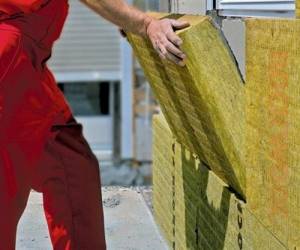
Installation of basalt wool
On the topic - how to insulate a door in a private house.
Glass wool
Made from industrial waste and broken glass. Its structure is formed by long elastic fibers. Available in rectangular mats and rolls. It has lower density and greater elasticity than basalt wool.
It is also fireproof and does not form harmful substances.
A major disadvantage is the reduction in thermal insulation characteristics when wet.
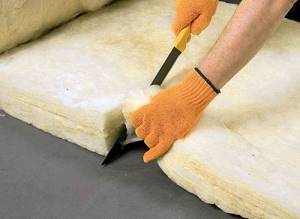
Cut glass wool
Expanded polystyrene
Foamed polystyrene is often called polystyrene foam. The material has good thermal insulation properties and is easy to install on rigid structures.
The main disadvantage of the material is that it burns well, and releases substances harmful to health. Polystyrene foam is also very fragile and not resistant to tensile and compressive loads; it chips easily. Extruded polystyrene foam does not have this disadvantage.
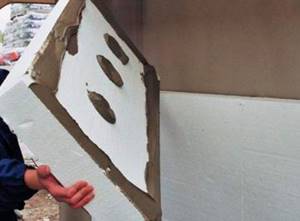
Installation of foam plastic with adhesive composition
Polyurethane foam
This foamed plastic, also called penoizol, has excellent thermal insulation properties. It is sprayed liquid, foams and hardens on the insulated surface in an even continuous layer without seams and without joints that cause heat loss.
It has excellent moisture resistance, zero hygroscopicity and vapor permeability. A significant disadvantage is the high cost of spraying equipment.
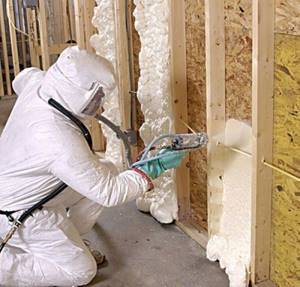
Spraying polyurethane foam
Ecowool
A new heat insulator on the Russian construction market is made of cellulose fiber impregnated with boric acid and sodium triborate.
The material is the most environmentally friendly, does not burn and does not form any harmful substances. It is also sprayed onto vertical surfaces, wetted with a water-adhesive composition.
The equipment costs less than for spraying polyurethane foam, but also seems expensive.
Auxiliary materials and tools
In addition to the insulation itself, additional materials will be required:
- vapor barrier membrane and double-sided tape for gluing its panels.
- External cladding: plaster or ventilated facade made of plastic or porcelain stoneware.
- Internal lining – moisture-resistant gypsum board, wallpaper.
- Products that prevent the development of mold and mildew
- Lathing made of wooden slats or metal profiles
- Fasteners
The usual tools are needed for general construction work. You will need:
- hammer drill or impact drill;
- construction knife;
- hacksaw;
- Bulgarian;
- screwdriver;
- tape measure, level, square.
To apply protective compounds you will need a spray gun or roller.
Buy a heater
Heaters differ in their operating principle - their cost also depends on this. They mostly run on electricity, so you'll need a free outlet.
- Fan heaters
are cheaper than others. They blow out a stream of warm air - the room heats up quickly, but unevenly. Among the disadvantages: fan heaters are noisy, dry the air very much, collect dust and over time begin to emit an unpleasant odor. The cost of fan heaters on Yandex.Market starts from 470 ₽. - Convectors
convert cold air into hot air. They operate silently, heat the room fairly evenly, and they also have a thermostat function that helps maintain the desired temperature in the room. Cons: convectors “burn” a lot of electricity and heat up slowly. The cost of convectors with normal power is approximately from 1 thousand rubles. - Oil radiators
look like an iron accordion filled with mineral oil, which is heated by electricity. Such heaters are silent, take a long time to heat up and cool down. Their cost is from 1–1.5 thousand rubles. - Infrared heaters
warm a room using infrared rays, which is why they glow orange-red. Silent and fast. Price - from approximately 600 ₽.
Features of a gravity heating system
The main disadvantage of installing a water heating system without mixer and manifold units is that it is necessary to minimize the loss of water temperature along the heater-circuit path, because the temperature on the floor covering must be kept constant.
It is recommended to take into account the following requirements:
- insulate the walls of the building;
- lay thermal insulation material in the floor covering cake;
- install high-quality window frame designs;
- install the floor covering as close as possible to the heater;
- the area of the room should not be more than 10-15 sq.m, otherwise it will not be possible to push through the circuit without an additional pump;
- It is better to choose pipes for a heated floor circuit with natural circulation with a diameter of 20 mm in order to reduce their hydraulic resistance.
Expert opinion Sergey Permyakov Heating systems engineer
Attention! The main mistake in installing a water brushless floor system is trying to use it over large areas. Therefore, it is necessary to calculate the duration of the pipes and the laying scheme so that the temperature in the return pipe is not too low
Otherwise, a lot of condensate will form in the boiler, and this will lead to its breakdown.
Put the carpet on the floor
Rugs are a proven way to warm up cold floors. And it’s even more comfortable with them.
If your budget allows, it is better to choose a carpet made of natural wool. Such carpets are more pleasant to walk on, they are more environmentally friendly and retain heat better. For example, at IKEA, handmade carpets made from natural materials cost from 3.5 thousand rubles, Persian carpets made from wool - from 10 thousand rubles. At Hoff, the price of wool carpets starts from 4 thousand rubles.
The cost of synthetic carpets at IKEA starts from 600 rubles, at Hoff - from 1 thousand rubles.
Concrete blocks
Concrete blocks are gradually replacing brick as a leader in the construction market. This is a more modern, cheaper and technologically advanced material. In addition, one block replaces from 4 to 14 bricks. Which significantly reduces construction time.
Concrete blocks are much lighter than brick and stone. Therefore, you can build a lightweight foundation and save money. The material of the blocks is not subject to rotting. Has a low fire hazard. The likelihood of insects and rodents appearing within the walls of a house is extremely low. A concrete block house will last as long as a brick house. Well, the cost, as already mentioned, is much lower.
The material also has tangible disadvantages. Almost every type of block is fragile. It has low moisture resistance and sound insulation. And a house made of concrete blocks needs external and internal finishing.
Related Posts
- Reviews from real owners about frame houses
- Fum tape technical characteristics, how and how much to wind on the thread
- Using wooden slats for wall decoration
- Kitchen design 10 sq.m. (+70 photos)
- How to properly caulk a log house
- How to glue fiberglass correctly?
- How to update old tiles in the bathroom
- Frame house using Finnish technology. what is the difference between Scandinavian frames
- Raising a house and replacing the foundation
- Prefabricated house: review of construction technology from large-format panels
- How to cut metal using a grinder
- The door handle creaks: causes of the problem and solutions
- How to build a veranda from wood
- How to build a country house with your own hands: plans and designs of finished houses (+photos)
- Stages of renovating a children's room
- Facade finishing
- Do-it-yourself insulation of walls with polystyrene foam - detailed instructions
- Foam block house, pros and cons
- Small houses for permanent residence
- Insulation of a veranda in a wooden house
- Alabaster: what is it? how to divorce? where to apply?
- Calculation of materials for a frame house
- How to make a ceiling in a private wooden house and do-it-yourself finishing
- How to seal the joint between the bathtub and the wall? 8 popular options
- We are not afraid of the gray wolf: straw house-building technology
Read with this
- Reviews from real owners about frame houses
- Fum tape technical characteristics, how and how much to wind on the thread
- Using wooden slats for wall decoration
- Kitchen design 10 sq.m. (+70 photos)
- How to properly caulk a log house
- How to glue fiberglass correctly?
- How to update old tiles in the bathroom
- Frame house using Finnish technology. what is the difference between Scandinavian frames
- Raising a house and replacing the foundation
- Prefabricated house: review of construction technology from large-format panels
Use an electric blanket or heating pad
An electric blanket, sheet or mattress are bedding items that can be plugged into an outlet and used to heat up your sleeping area. Good appliances have several heating modes that are controlled by remote control - you can change the temperature without getting out of bed. Such accessories can be ordered, for example, on Wildberries (from 2.5 thousand ₽) or Ozon (sheets - from 1.5 thousand ₽, mattresses - from 1.7 thousand ₽, blankets - from 2.8 thousand ₽).
You can also take a heating pad with you to bed. An ordinary rubber heating pad, into which you need to pour boiling water, can be bought for 190 ₽. The cost of electric heating pads, which can maintain heat all night, starts from 700 ₽. As a last resort, you can use the “old-fashioned” method and pour hot water into a plastic bottle - it is better to wrap it in a towel so as not to get burned.

